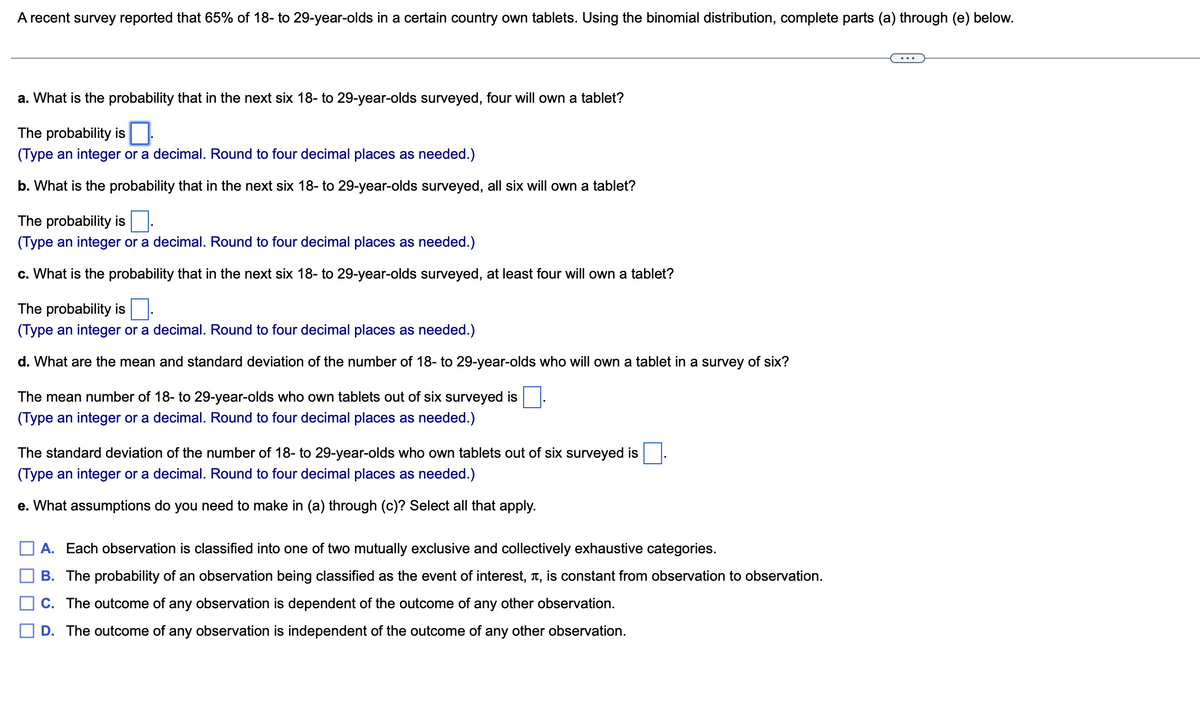A recent survey reported that 65% of 18- to 29-year-olds in a certain country own tablets. Using the binomial distribution, complete parts (a) through (e) below. a. What is the probability that in the next six 18- to 29-year-olds surveyed, four will own a tablet? The probability is (Type an integer or a decimal. Round to four decimal places as needed.) b. What is the probability that in the next six 18- to 29-year-olds surveyed, all six will own a tablet? The probability is. (Type an integer or a decimal. Round to four decimal places as needed.) c. What is the probability that in the next six 18- to 29-year-olds surveyed, at least four will own a tablet? The probability is. (Type an integer or a decimal. Round to four decimal places as needed.)
A recent survey reported that 65% of 18- to 29-year-olds in a certain country own tablets. Using the binomial distribution, complete parts (a) through (e) below. a. What is the probability that in the next six 18- to 29-year-olds surveyed, four will own a tablet? The probability is (Type an integer or a decimal. Round to four decimal places as needed.) b. What is the probability that in the next six 18- to 29-year-olds surveyed, all six will own a tablet? The probability is. (Type an integer or a decimal. Round to four decimal places as needed.) c. What is the probability that in the next six 18- to 29-year-olds surveyed, at least four will own a tablet? The probability is. (Type an integer or a decimal. Round to four decimal places as needed.)
Chapter8: Sequences, Series,and Probability
Section8.7: Probability
Problem 50E: Flexible Work Hours In a recent survey, people were asked whether they would prefer to work flexible...
Related questions
Question

Transcribed Image Text:A recent survey reported that 65% of 18- to 29-year-olds in a certain country own tablets. Using the binomial distribution, complete parts (a) through (e) below.
...
a. What is the probability that in the next six 18- to 29-year-olds surveyed, four will own a tablet?
The probability is:
(Type an integer or a decimal. Round to four decimal places as needed.)
b. What is the probability that in the next six 18- to 29-year-olds surveyed, all six will own a tablet?
The probability is
(Type an integer or a decimal. Round to four decimal places as needed.)
c. What is the probability that in the next six 18- to 29-year-olds surveyed, at least four will own a tablet?
The probability is:
(Type an integer or a decimal. Round to four decimal places as needed.)
d. What are the mean and standard deviation of the number of 18- to 29-year-olds who will own a tablet in a survey of six?
The mean number of 18- to 29-year-olds who own tablets out of six surveyed is
(Type an integer or a decimal. Round to four decimal places as needed.)
The standard deviation of the number of 18- to 29-year-olds who own tablets out of six surveyed is
(Type an integer or a decimal. Round to four decimal places as needed.)
e. What assumptions do you need to make in (a) through (c)? Select all that apply.
A. Each observation is classified into one of two mutually exclusive and collectively exhaustive categories.
B. The probability of an observation being classified as the event of interest, T, is constant from observation to observation.
C. The outcome of any observation is dependent of the outcome of any other observation.
D. The outcome of any observation is independent of the outcome of any other observation.
Expert Solution
This question has been solved!
Explore an expertly crafted, step-by-step solution for a thorough understanding of key concepts.
This is a popular solution!
Trending now
This is a popular solution!
Step by step
Solved in 2 steps

Recommended textbooks for you


Algebra and Trigonometry (MindTap Course List)
Algebra
ISBN:
9781305071742
Author:
James Stewart, Lothar Redlin, Saleem Watson
Publisher:
Cengage Learning


Algebra and Trigonometry (MindTap Course List)
Algebra
ISBN:
9781305071742
Author:
James Stewart, Lothar Redlin, Saleem Watson
Publisher:
Cengage Learning